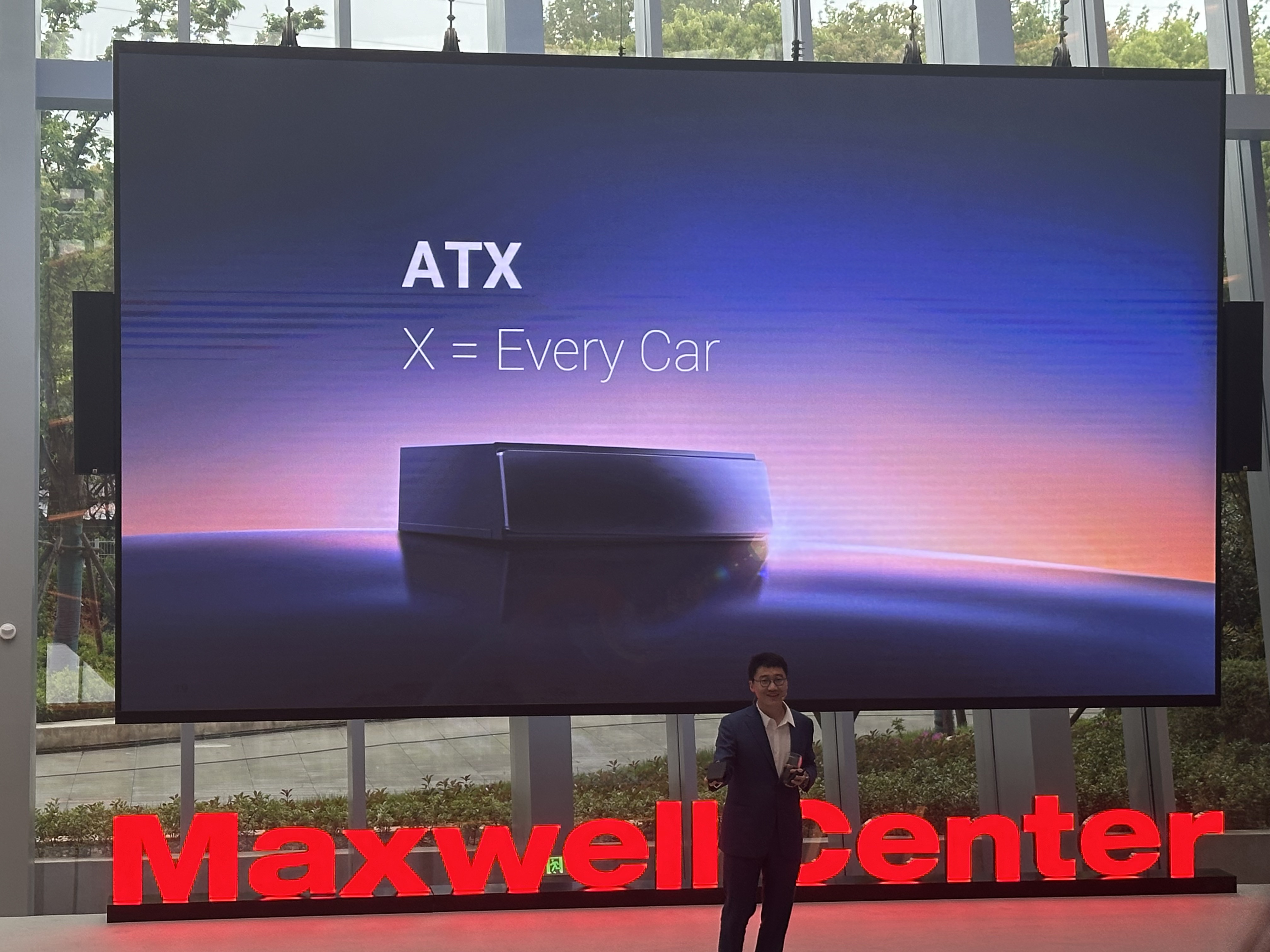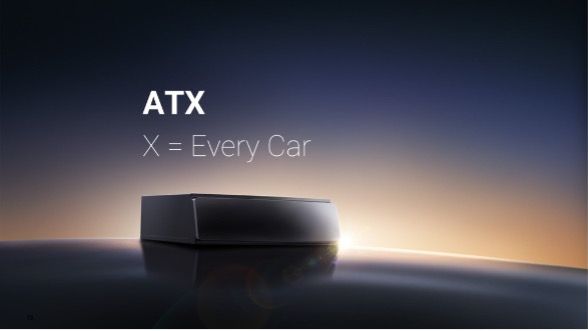Hesai announced its new LiDAR ATX on April 19th.
Key features include:
- ATX is 60% smaller and 50% lighter than the commonly used AT128. Overall power consumption has been reduced by 55%.
- The reduced size means that if mounted on a car roof, air resistance will be cut down. It can also be fitted in the headlight position and behind the windshield.
- Maximum detection range of 300m. Hesai CEO Li Yifan commented that a larger detection range not only means object detection is possible earlier but also implies clearer short distance object detection.
- It can support up to 256 lines, with an angular resolution of 0.08° x 0.1°.
- A field of view of up to 140° for city driving and a maximum range of 500m along with 7x HD perception for highway driving.
Significantly, Hesai also announced its self-developed Intelligent Point Cloud Parsing Engine (IPE). According to Hesai, IPE can filter out over 99.9% of environmental noise during driving.
For instance, while driving in rain or fog, the rain, fog, and mist rising from the tyres can interfere with the LiDAR. ATX with IPE can filter out these potential disruptions to the perception of the road environment.
As revealed by Hesai, ATX already has many mass production locations, including leading car manufacturers within China, top new energy vehicle firms, emerging forces, as well as top European and American automobile factories. Production is expected to begin in the first quarter of next year.
Vehicles equipped with ATX might offer enhanced high-speed and city piloting experience. The primary curiosity remains about the amount of extra cost for ATX-equipped vehicles.
At the press conference, Hesai’s CEO Li Yifan did not reveal ATX’s price, but he shared his thoughts on LiDAR and the industry during a session with the media.
The main points from the media exchange are edited below without altering their original meaning.

Q: How many cars driven by Hesai employees are equipped with LiDAR?
That number is limited. The reasons are two-fold: firstly, I don’t really know what cars everyone drives; secondly, LiDAR penetration itself is not high enough.
Furthermore, the question you may want to ask is how can the average public accept this product if even Hesai’s employees don’t have a high understanding of LiDAR?
This is a very realistic problem. The experience brought by LiDAR to customers is not high enough, apart from being seen by others. This is a problem we need to resolve.
We are approaching this from two directions: first, offering a LiDAR that is cheap yet functional.
The second direction focuses on customer psychology. For instance, even if they don’t use it, customers want to have airbags. Think of LiDAR as an airbag. But this understanding needs spreading among customers. I believe customers will in the future buy LiDAR like an airbag.Q: Does Hesai do software?
Firstly, for the lidar, we do strike a balance between the software and hardware. For example, our lidar can identify whether a point in a point cloud is rain or dust based on its hardware and software.
However, we have yet to find an optimal business model for a purely software system. Hesai does possess the capability to do full stack perception, and we have delivered this software to some clients.
Why do I believe this isn’t an excellent business model? We’re discussing two things. Firstly, a Lidar can’t make decisions independently; it needs to integrate with the host’s system.
If we venture into the software part, won’t there be a lack of value for the vehicle companies? If it doesn’t generate value for the vehicle companies, how can we establish a business model? I ponder over this question annually, but what we have observed thus far is that vehicle companies prefer the high-quality primary data, and they use their algorithms and other sensors for fusion.
Q: Is there any possibility that in the 150,000-250,000 or 200,000-300,000 market, assisted driving will move towards pure vision, and higher-priced products will use lidar?
The chance will always exist.
I cannot claim that it’s impossible. Ultimately, it comes down to cost-effectiveness. Can it help vehicle companies sell cars and control costs? It’s an ensemble of factors, so there’s always a chance.
Q: If everyone has completed chipization, will the future improvement of Hesai Lidar’s performance need to consider new technological methods?
Completing chipization does not mean the performance will no longer improve. For example, our AT128 has a high level of chipization, but it doesn’t mean we can’t add more lasers, receivers, or computational ability in a lidar of the same size.
By the time we reach the fourth-generation platform, both our chips and components will be better. This situation is independent of chipization.
As for the choice of technological route, it mostly boils down to business concerns.
Q: Does Hesai have an end-to-end solution based on the fusion of LiDAR and vision?
End-to-end is a methodology that can address many open issues and reliance on data from intelligent driving.
From the information available, I don’t see a direct connection between end-to-end and lidar, which are relatively two different things. Lidar solves many vision-related problems, not intelligence issues, whereas end-to-end fundamentally changes the thinking pattern.
Q: If Hesai wants to continue to increase its market share, have there been thoughts on the second growth curve?
Even if our market share rises to 60%, 80% or 100%, we still face many challenges. Regardless of whether the industry can cross the chasm or the actual cost can be reduced, we need to devote a lot of effort to the first growth curve in the face of competition.Also, we are constantly paying attention to the second growth curve, we’ve made numerous attempts, but usually, the second curve is not something a listed company would disclose. We will communicate with everyone at the appropriate time.
Q: Some models cut off the lidar sensor solution for cost reasons, how does Hesai view this trend?
This is actually due to the influence of millimeter-wave radar.
Because the wavelength of millimeter-wave radar is longer, it’s inherently difficult to achieve a high resolution. In terms of resolution, millimeter-wave radar has about 1% of the number of points of lidar, which means it can’t really replace lidar.
Another factor is cost-performance ratio. If you want to achieve a relatively high resolution with 4D millimeter-wave radar, it won’t be so cheap. You can’t compare the anticipated price of 4D millimeter-wave radar with the price of lidar sold years ago. You should consider the long-term outlook for both lidar and 4D millimeter-wave radar. Don’t forget, there’s an order-of-magnitude performance difference between the two.
All things considered, I don’t believe that 4D millimeter-wave radar can replace lidar, especially for advanced ADAS.
Q: What is ROI and do Hesai’s products set an ROI values?
The term ROI seems a bit like a coinage. Normally, the lines of radar or camera are evenly distributed, and the number of lines determines the vertical resolution. This is a simple concept. Indeed, sometimes the focus on the edges won’t be as high as in the middle and in our approach, we do not matter whether it’s high or not, we just keep it evenly distributed as it comes from the camera.
Some players’ strategy is to give a denser distribution to the parts with less focus, leaving the rest less dense. This is actually pretty smart and there’s no issue with it. The only problem is how much to give and how to give it, this definition is not quite clear. That’s why I’m not too fond of the term ROI.
If there’s only a small dense part, we’ll consider the density of the dense part equivalent to how many lines it would occupy if it took up the whole screen. This is somewhat like saying I got a bonus of 100,000 at the end of the year, that’s the money I received on a certain day, then I equate it with an annual income of 30 million.
But I do see the value in ROI. However, we are a company that values substance. We’d rather stick to a certain number of lines, rely on the very hardcore chip technology, give everyone these many lines. For these two reasons, we didn’t proceed with ROI.
This article is a translation by AI of a Chinese report from 42HOW. If you have any questions about it, please email bd@42how.com.
